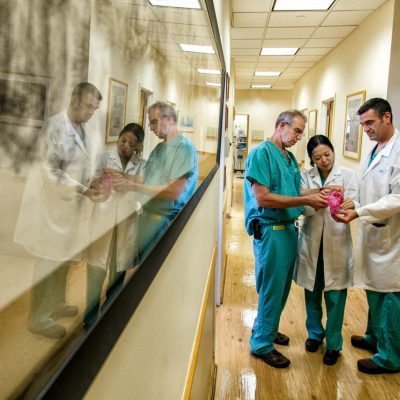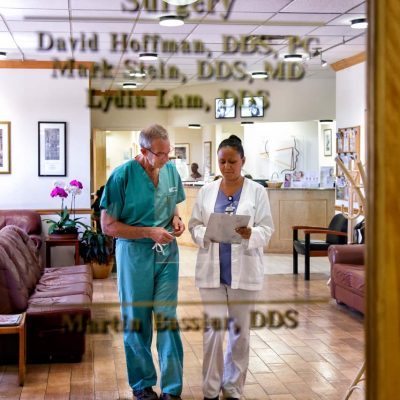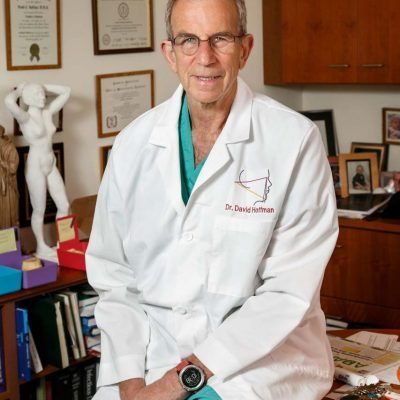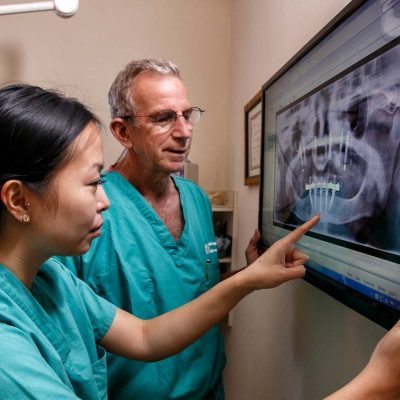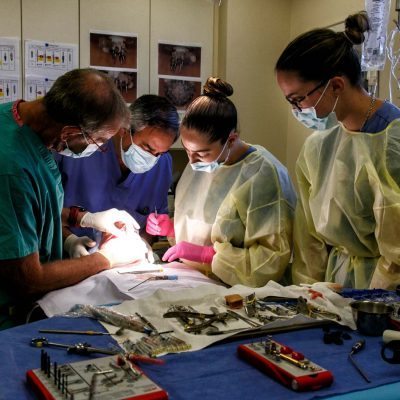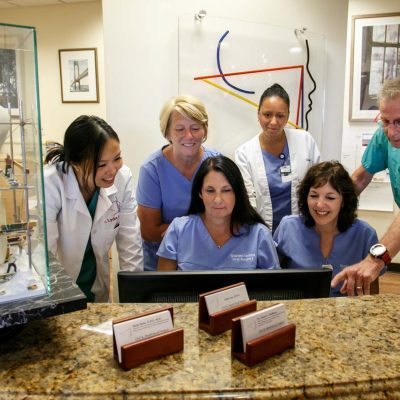An Oral and Maxillofacial surgeon specializes in giving people their smiles and quality of life back
By JENNIFER VIKSE • Photos By Amessé Photography
On a recent afternoon, Dr. David C. Hoffman, D.D.S., could be found in the hallways of the New York Academy of Art. There to lecture, he wasn’t talking about oral surgery-his specialty-or even the highly technological procedures he and his team regularly perform at their practice, Staten Island Oral Surgery & Maxillofacial Surgery. He was there to talk about art…more specifically, sculpture.
“Put together, surgery and sculpture are a super neat experience,” noted Dr. Hoffman, who is board certified by the American Association of Oral and Maxillofacial Surgeons as well as the current director of the Division of Oral and Maxillofacial Surgery at Staten Island University Hospital. “It’s so entwined, like a right hand and left hand. I can’t imagine being a facial surgeon without being a sculptor. I also can’t imagine being a sculptor without being a surgeon.”
Several of Dr. Hoffman’s pieces grace the office he shares with Dr. Mark Stein and Dr. Lydia Lam, which is located on the campus of Staten Island University Hospital, part of the Northwell Health System.
“It’s really a unique office,” he noted proudly. It showcases not only Dr. Hoffman’s sculptures, but photography of New York City scenes, bridges, and some pieces from Academy of Art students. “It could double as an art gallery.”
After completing his dental surgery residency at Parkland Memorial Hospital Southwestern University of Texas Health Science Center in Dallas, Hoffman returned to Staten Island in 1981. Fast forward 35 years, and he’s practicing alongside colleagues trained in the world’s most advanced dental and maxillofacial techniques.
“When I was applying to oral surgery programs, a classmate said I should apply at Parkland. I didn’t realize that it was the premiere program in the world, and the chairman took a liking to me. It just put me in the limelight. I was at the place where people were writing the textbooks,” he recalled. “That changed my life because it opened my eyes to doing a lot of neat things.”
When he’s not sculpting or in surgery in Staten Island, Hoffman is volunteering with Healing the Children, an international organization that secures much needed surgery and other medical care for children in Third World countries, treating cleft lip, cleft palate, and other facial deformities.
“I always had an interest in kids born with clefts,” said Hoffman. “When you are fresh in your field, you like challenging situations. Babies born with clefts are like a jigsaw puzzle. You have to have a lot of skills and do a lot along the way.”
As a young surgeon, Hoffman was intrigued by the idea of helping children in Latin American nations. After several unsuccessful attempts to schedule a first trip, he finally travelled to Honduras after other doctors bailed out because of the potential danger.
“I’m 30 at the time, I’m wet behind the ears,” he recalled. “I wasn’t married, I didn’t care (about the danger), so I went.”
That trip opened his world to Healing the Children’s work and other opportunities that would allow him to help children with cleft palate and facial deformities. “I haven’t looked back since,” he said. “It’s been 50-something trips. I’ve lost track.”
By happenstance, Hoffman met one of the principals of Healing the Children, and she knew an engineer from Colombia who suggested the organization use a hospital in the city of Neiva for their surgeries. In time, the Neiva hospital’s parking lot was used to screen hundreds of children who turned out hoping for treatment. Surgeries were performed over five-day stretches using five of the hospital’s operating rooms.
“If you would have said I’d be doing this 20 years in a row—with 23 years in Neiva—I wouldn’t have believed you,” Dr. Hoffman said. Now, he added, 200- 300 children get their surgeries each year.
On a recent trip, Hoffman strolled around the old operating rooms in Neiva, which have since been replaced by state of-the-art facilities. “I can remember being at this one table for an endless amount of time, being so tired. I’ve been in every spot in this place. It’s time to let someone else do it,” he recalled thinking. “Teaching has become a main focus.”
In addition to teaching, he is also serving as chair of a humanitarian aid committee for the World Health Organization. (“In the past few years, I’ve gotten to branch out some more,” he said. “I’ve gotten involved in international maxillofacial surgery.”) He’s also working on genealogy projects involving cleft palate and a study to try to prevent club feet and hip dysplasia. “It’s been a neat twist in my profession. It occupies a lot of my thoughts and time.”
And he’s not just helping children outside of the United States. For Dr. Hoffman and his Staten Island partners, changing people’s lives is an everyday occurrence.
With a practice that encompasses Temporomandibular Joint Disorders (TMJ) and surgery, facial trauma orthognathic surgery, oral pathology, and other procedures, the doctors know bone grafts and dental implants have made a huge impact for those living with tooth and bone loss.
Years ago, Hoffman recalled, “I would pull teeth. That would be the end of it. I wouldn’t see the patient again. They’d live with a bridge, or a denture,” adding that over the last several years, much in that area has been transformed. “There’s been a change in dentistry over the last 30 years…a whole shift in philosophy; we are taking out hopeless teeth, we are replacing them with bone grafts…dental implants. We’re giving people their bite back.”
While implants have been around for about 20 years, they’ve gained widespread popularity in the last five or six, according to the team at Staten Island Oral Surgery & Maxillofacial Surgery.
“Baby boomers wanted implants,” Dr. Hoffman said. “Before you do these elaborate procedures to try to save a tooth, this works. It’s more predictable. If there’s only a shell left, why not put an implant in?”
People need implants for any number of reasons. One of the ways people lose their teeth is from bone loss. The bone that holds teeth in place is very specialized and tooth loss can occur as that bone wears away. Tooth loss can also be cause by periodontal (gum) disease, poor dental care and a simple fear of going to the dentist.
In addition, there’s a self-esteem component, noted Lydia Lam, DDS. “A lot of people are used to not smiling, they cover their mouths,” Dr. Lam said. “If they wear dentures, they are always worried about them falling out of their mouth, so they don’t go out to eat.”
There’s another more physical aspect to the self-esteem problem. When someone is missing teeth, their face gives the appearance of collapsing inward. “To be able to give someone a full, beautiful set of white teeth, it really is a confidence boost,” Dr. Lam added. “When you put teeth back in, the whole facial appearance changes. Any sort of cosmetic dental work is a booster.”
An implant is held in place by a titanium screw; the benefit of that is that the bone will harden around the screw and seal it off. “Whatever the cause [of the loss] was, it won’t affect the implant. The implant will do well,” Hoffman said.
The titanium/bone relationship was discovered by a Swedish physician and research professor, Per-Ingvar Branemark, who was looking for a metal that would work well with bone. Happily, titanium and jawbone proved a perfect fit.
“It’s a very exciting field to be in,” Dr. Hoffman said, but recalled that implants were a tough sell when they were new to the market years ago.
“Surgeons were trained at putting them in,” he said, “but people considered them experimental.”
Over the last 15 years, this procedure has become a popular option. “Now, the public knows a lot about it,” he said. “In the last five to six years, I don’t have to sell it.”
In the last few years, innovations in implant technology have completely changed the way the doctor and his team give people back their smiles.
One method, nSequence, is Internet based and begins with a simple CAT scan right in the office. From that imaging, the surgeons can create models of new teeth, based on the scan of the jawbone and any remaining teeth. It’s high-tech work.
“We treat and plan as virtual surgeons,” explained Dr. Lam. “We’re doing a lot of innovative things. This is the most sophisticated way to do it.”
The procedure is simple, at least for the patient. Doctors take the photos, scan them electronically after the patient goes home, and the surgeons do all of the procedural planning online and design the surgery. “There’s no more office time for the patient. You can simulate all of the implant placement and present an image of what their profile change will be with teeth,” Dr. Lam explained.
“In a matter of four hours, they walk in with no teeth and walk out with teeth they can eat with,” she said of the custom-made replacements, usually made from zirconium or porcelain. And reduced surgical time means less healing time. “The difference is the way we do it,” Lam said. “Our end is pre-planned and custom fit, so that leaves very little room for mistakes. With this new technology, we really nailed it down to a precise science.”
Dr. Hoffman equates the system’s ease of use to assembling furniture from Ikea. His practice is one of the few in the area currently using the technology.
Once the online component is done and the surgery has been planned, the necessary materials arrive in a box. “Everything just fits together,” Hoffman said. “It tells you where to place things. You’ve basically already done the surgery on the computer. The teeth are already made instead of provisional teeth. You can wear those for four months to two years and then get a set of final teeth.”
One of the best parts of this technology is that patients don’t have to endure a year or more of waiting to see results. Years ago, a graft would have meant wearing a denture for some time and then moving on to the implant.
“If they have decided to do something, they want to do it now. This is a big boost for patients,” noted Hoffman. “This has a lot of sex appeal. It’s instant gratification.”
Another technology that has changed the shape of implants is the use of a bone morphogenetic protein (BMP) graft. This protein stimulates the growth of the jawbone.
“With this protein, we can build a structure-enough bone that we can put implants in,” explained Dr. Lam, noting that people with almost no bone were not candidates for implants before. “Their jaw might look like an index card, and six months later we can put in implants. Science that didn’t exist five years ago is now commonplace. We can help people who would be crippled with no chance at all for implants.”
Another option that Dr. Lam offers is the zygomatic bone implant.
The zygomatic bone (or cheekbone) can substitute for the jaw when a patient doesn’t wish to undergo extensive lower and upper jawbone grafting, or for those who may have had a tumor or part of the jaw removed.
“We can put in implants in the zygomatic arch,” explained Dr. Lam, noting that the implant would extend to the necessary length. “The cheekbone is great. It [the implant] wouldn’t change the appearance of your face, but allows for a really solid foundation.”
The procedure, which is about a decade old, is another choice for people who might find themselves in a tough spot. “We’re not saying sorry, we can’t help. This is another thing we can do,” Dr. Hoffman said.
While the practice has embraced new technology-and Hoffman himself helped create the Total Joint Replacement System for the temporomandibular joint-he cautioned that as much as technology has given to patients, you never want them to feel like they are being experimented on.
“You don’t want to be the first guy on the block to do something,” he said. “We’ve pioneered a lot of things. They work really well. You’re not experimenting on your patients. We’re taking care of people that are really counting on us. We want to know it works.”
And the principals of the Staten Island practice also acknowledge that any dental surgery is a significant financial investment. In regards to the nSequence procedure, Dr. Hoffman said that replacing all of one’s teeth is pricey.
“When you are replacing all of your teeth, it’s an expensive proposition-about $30,000 with everything included,” he said. “Very few people can write a check for $30,000. You have to plan it out. We understand when we tell someone the cost that it’s not to be taken lightly.”
The bottom line, according to Dr. Hoffman, is that dental surgery has embraced and employed modern technology, much to the benefit of patients.
“We can take the most complex patients and secure a solution in the safest way,” he said. “We’ve got, nestled in Staten Island, a sophisticated program that is in the forefront of modern technology. This is a place where really sophisticated things are going on.”
Staten Island Oral Surgery & Maxillofacial Surgery
256 C Mason Avenue / 718.226.1251 / statenislandoralsurgery.com



